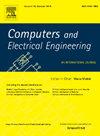采用MOSFET的蔡氏二极管的主动实现
IF 4
3区 计算机科学
Q1 COMPUTER SCIENCE, HARDWARE & ARCHITECTURE
引用次数: 0
摘要
这项研究工作只使用了两个基于金属氧化物半导体场效应晶体管 (MOSFET) 的 Chua's 二极管就完成了 Chua's 电路设计。这种设计具有以下优点(i) 使用的晶体管数量最少;(ii) Chua's 二极管中没有无源元件;(iii) 封装密度高,芯片面积为 108.9 μm2;(iv) 适合产生所有基本分岔序列。使用 Cadence 的 Virtuoso 工具和 gpdk 180 纳米技术参数,以及工艺、偏置(偏置电流)和温度变化分析,验证了电路的可操作性。此外,还使用市售的 N-MOSFET (2N7000) 进行了实验验证。所提出的设计适用于用于安全通信的混沌振幅偏移键控(CASK)传输。最后,还与现有的 Chua 电路进行了比较分析。本文章由计算机程序翻译,如有差异,请以英文原文为准。
Active implementation of Chua’s diode employing MOSFET
This research work contributes a Chua’s circuit design using only two Metal-Oxide- Semiconductor-Field-Effect-Transistor (MOSFET) based Chua’s diode. This design enables the following advantages like: Use of a minimum number of transistors, Absence of passive components in Chua’s diode, High packaging density with 108.9 m chip area, Suitable for the generation of all fundamental bifurcation sequences. The workability of the circuit is verified using Cadence’s Virtuoso tool with gpdk 180 nm technology parameters, along with the process, biasing (bias current), and temperature variation analysis. Moreover, an experimental validation is performed using commercially available N-MOSFET (2N7000). The proposed design is suitable for Chaotic-Amplitude-Shift-Keying (CASK) transmission for secure communication. At end, a comparative analysis is done with the available Chua’s circuit.
求助全文
通过发布文献求助,成功后即可免费获取论文全文。
去求助
来源期刊

Computers & Electrical Engineering
工程技术-工程:电子与电气
CiteScore
9.20
自引率
7.00%
发文量
661
审稿时长
47 days
期刊介绍:
The impact of computers has nowhere been more revolutionary than in electrical engineering. The design, analysis, and operation of electrical and electronic systems are now dominated by computers, a transformation that has been motivated by the natural ease of interface between computers and electrical systems, and the promise of spectacular improvements in speed and efficiency.
Published since 1973, Computers & Electrical Engineering provides rapid publication of topical research into the integration of computer technology and computational techniques with electrical and electronic systems. The journal publishes papers featuring novel implementations of computers and computational techniques in areas like signal and image processing, high-performance computing, parallel processing, and communications. Special attention will be paid to papers describing innovative architectures, algorithms, and software tools.
 求助内容:
求助内容: 应助结果提醒方式:
应助结果提醒方式:


